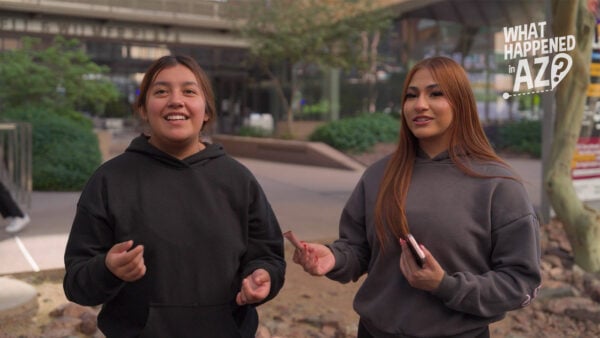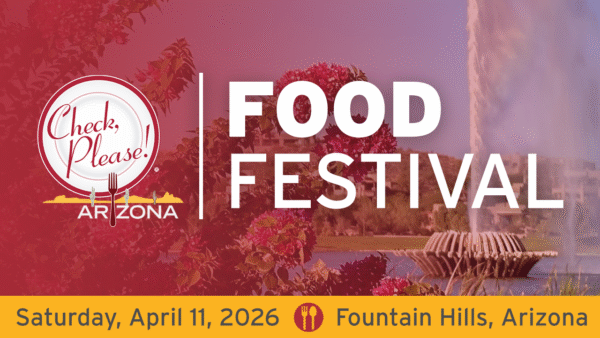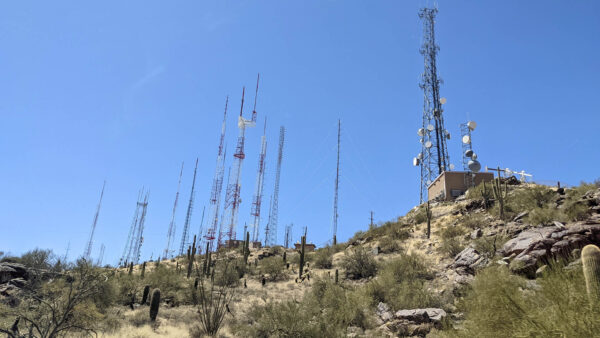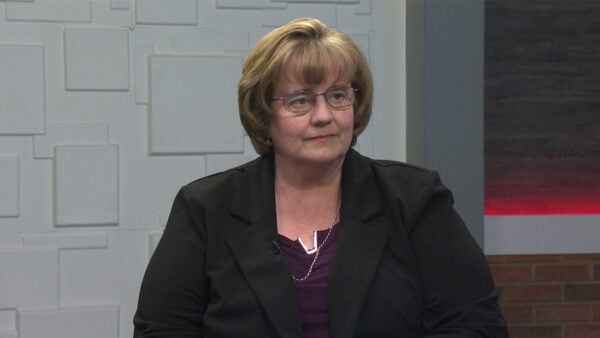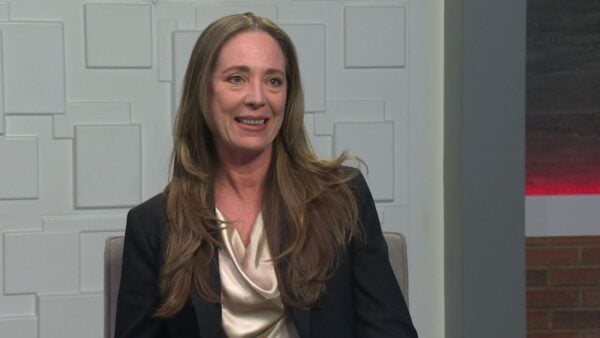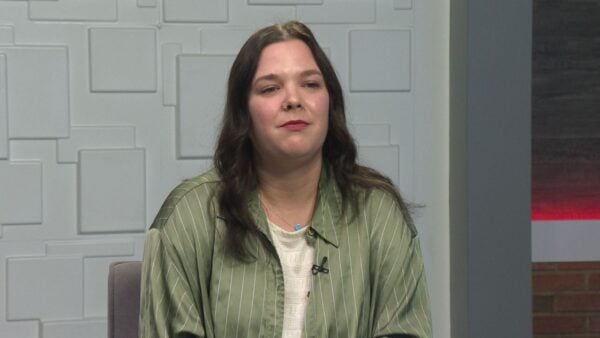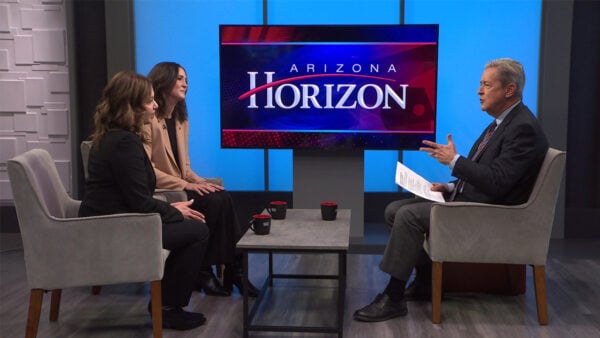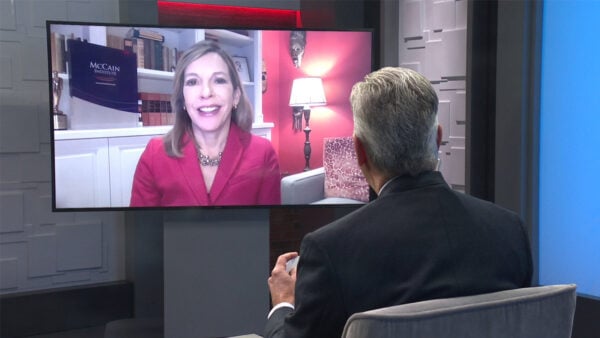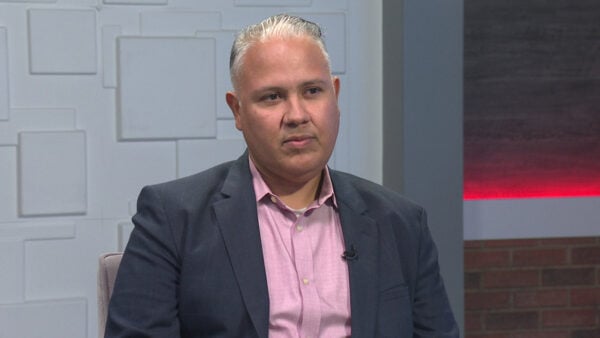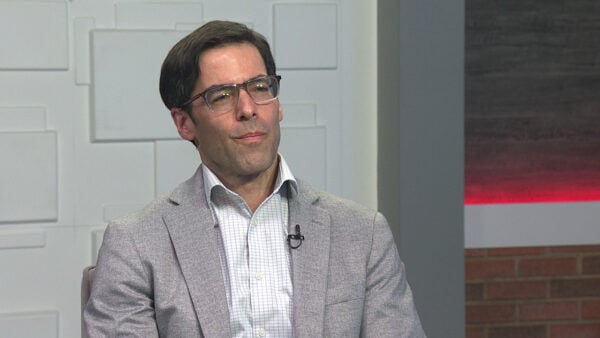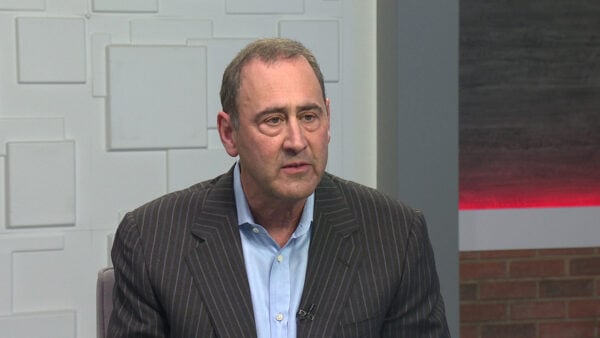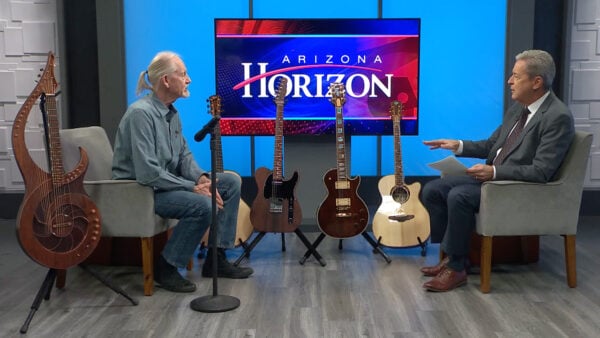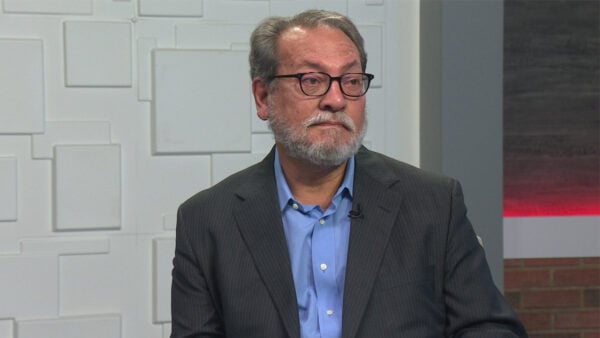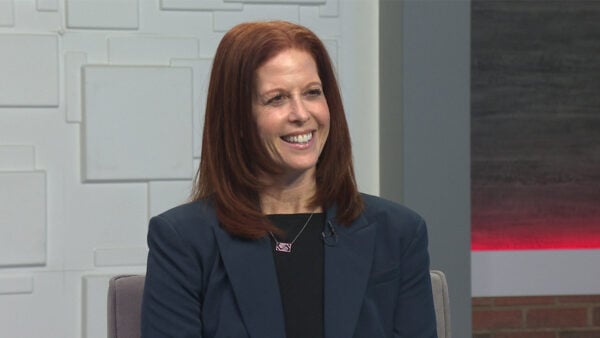Two new reports show a rise in people using social media to get their news content while at the same time newspapers continue to decline. Jessica Pucci, an ethics and excellence professor of practice for Arizona State University’s Walter Cronkite School of Journalism and Mass Communication and a specialist in data analysis and audience engagement, will talk about why more people are turning to social media for their news.
Ted Simons: Coming up next on "Arizona Horizon" -- we'll see how proposition 123 money is going into Arizona schools. Also tonight, why more people are turning to social media for news content, and we'll meet the author of a book on America's unique relationship with the coyote. Those stories next on "Arizona Horizon."
Video: "Arizona Horizon" is made possible by contributions from members of PBS, members of your PBS station. Thank you.
Ted Simons: I'm Ted Simons. A state lawmaker today pleaded not guilty to charges of welfare fraud. Cici Velasquez was arraigned on three counts of fraudulently using $1700 worth of food stamps. She released a statement saying she's anxious to have her date in court. Her pretrial conference is August 17.
Ted Simons: Arizona schools are starting to receive increased payments from the state land trust by way of proposition 123, which helped settle a lawsuit over inflation adjusted funding. Joining me now is Jeremy Calles, chief financial officer at the Kyrene elementary school. Thanks for joining us. When did the money start coming in.
Jeremy Calles: The cash is available now. By having a special election in may we gets that funding for the '15-16 school year, the year we just completed. We those funds in as well as over the course of the next 12 months as we get our payments for the current school year we'll start to received next payment.
Ted Simons: As far as the money -- just logistically how is the money presented to the district?
Jeremy Calles: Well, it's all available for the first payment at once. Districts actually work off budge capacity. When you know your total funding for the entire year it's like all that is available at the beginning of the year. The money for last year as well as this year is available to school districts now. They can start spending it now. They make plans for how to spend that money based on. That they weren't forced to spend last year's money in last year's budget so all that could roll forward, give them more time to plan and determine the best course of action.
Ted Simons: Basically you got an entire year's worth in one lump sum?
Jeremy Calles: yes. The whole first year came in one lump sum. Some districts decided because of that to go ahead and implement some increases for last year. Give employees who may not even be continuing this year give them increases last year because of the salary freezes and everything else we have had to endure during this entire time where the state stopped funding for inflation.
Ted Simons: when does the next payment hit for the current year?
Jeremy Calles: It will start to come in. We get 12 payments over the course of the year. It will be broken out and prorated.
Ted Simons: not a lump sum for that.
Jeremy Calles: No.
Ted Simons: Is it still for this money is it still tied to enrollment?
Jeremy Calles: Yes. It was an increase on the per pupil amount. The amount of funding we received for each student actually got adjusted and increased. Based on the number of students every district has determines how much funding they get.
Ted Simons: how is it determined how to spends the money? How is it decided?
Jeremy Calles: There's a process at every district. We have mete and confer groups. We're not a union state but we have meet and confer groups, three employee groups. Teachers are uncertified. You have education support professionals, classified staff, then administration. They work along with the district administration and with the governing board to bring forward recommendations. Then the governing board makes a decision on how those will be invested back into the education for that community.
Ted Simons: The governing board has already made those decisions?
Jeremy Calles: Yes. Those decisions have all been made. The budgets for next year officially get adopted before July 15, so those meetings are still taking place. For the most part those decisions have been made on how to invest those funds.
Ted Simons: in general how much of those will be invested by way of teacher salaries?
Jeremy Calles: Large portion of them are going towards teacher salaries. It's been from one of the primary issues for many districts although it's not the only issue. The inflation cut that we received for inflation wasn't the only cut we took during the recession. Many other cuts still haven't been restored, so districts have some other needs but they also needed to get that addressed. That will vary by district. With a lot of my counterparts, I talked to CFOs, a heavy emphasis on teacher compensation. Another thing we need is educational resources. Textbooks. One of the areas we have been cut in significantly is capital. Right now we get about $77 per student to cover all capital needs. Those capital needs include things like the students' desks, chair, textbook, their technology. Everything that you need for a student. You're only getting 77 a year for T. because of that districts have not adopted new textbooks in 12 years and the standards have changed three times since then so you're asking the teacher this textbook was developed for a different standard, keep trying to make it work for this new standard even though it's knot written exactly the same. Try to make it work because we haven't had the funds to be able to do that. Some of the other areas people have cut some of the elective programs, arts, music, P.E., things that enhance the learning experience. Those have taken significant cuts so people are also trying to make restoration in those areas.
Ted Simons: some are concerned that some of this if not most of this money would go to administration. How much goes to administration?
Jeremy Calles: Well, I can speak specifically for Kyrene, many districts are taking a similar approach. First when you're working with all three employee groups you want to honor and respective employee that makes the district great. From the custodians, teachers, principals, everyone who is contributing. So you typically try to do increases that are mostly in line between the three employee groups. That being said, a lot of districts have done other things to give additional compensation increases to the teachers. For instance in Kyrene one thing we have done is added two additional contract Dates for the teacher. That doesn't make their per day reimbursement go up. Their annual salary is increased and the two extra days are nonstudent contact days, allowing them more time for professional development and planning.
Ted Simons: but some of this will be going to administration.
Jeremy Calles: Yes.
Ted Simons: Do we have a percentage? Vague, ballpark?
Jeremy Calles: I would say in Kyrene administration over all represents about 6.7% of our total spending. So then I would say roughly about that same amount would be going towards compensation for administration.
Ted Simons: last question, very quickly here, critics say more money does not equal better results when it comes to education. Respond to that, please.
Jeremy Calles: well, I think it depends on how you use the money. I would say definitely it if you're going to throw money at a problem it's not going to solve it, but when you look at the critical needs and things that have been reduced over the past few years like full day kindergarten, the state only pays for a half day program when it's proven a full day program is needed to meet the move on reading requirements that are put into place for third grade. Things like all of our capital needs, we have degrading facilities because of the cuts with capital, not just the soft capital, desks and chairs, but even the building renewal items have been cut. All those items do need to be addressed. While addressing them may not automatically show you an immediate impact on achievement ignoring them will show a detriment.
Ted Simons: Jeremy, good to have you.
Jeremy Calles: Thank you, Ted.
Ted Simons: Recent reports show an increase in the use of social media for news content. This as traditional newspapers continue to decline. For more we welcome Jessica Pucci, an ethics and excellence professor of practice at ASU's Walter Cronkite school of journalism and mass communication and a specialist in data analysis and audience engagement. Good to have you.
Jessica Pucci: Thanks for having me.
Ted Simons: what is social media?
Jessica Pucci: Social media is any digital network that allows people around the world and in small communities and families and friends to connect.
Ted Simons: And so how are people getting news from social media?
Jessica Pucci: People are getting news from social media more than they ever have in the history of social media. People are sharing stories with each other, with friends and families. More importantly, publishers of news, newsrooms and individual journalists have really joined the social media bandwagon and are now really making very strong efforts to share their news in social media networks.
Ted Simons: So why are more people opting for social media to get their news?
Jessica Pucci: it's an interesting question. We really saw -- we have seen a big shift in the way people consume their news. It used to be you got your news from your neighbors, your family, friends. Then as journalism really operationalized itself, you saw the emergence of journalists as gate keepers. Journalists really curating for their audiences what was important to know. It wasn't just your friend telling you what was important, what was going on in the town square that you needed to know, it was somebody trained in news judgment. It really became a true profession to understand and digest and share the news. It now we have kind of come full circle and we have journalists being the gatherers and creators of deliverable news, but now we have individuals, your family, friends, the same people who are you are associated with on social networks also being gate keepers. Now you have not only trained journalists with that responsibility, now your friends and family are the gate keepers. On social media we are all equal. My Facebook account is the same as yours and my mom's and my grandma's. They are able to share news that they deem worthy.
Ted Simons: With that in mind what are the advantages, what are the disadvantages of everyone getting their news, their information, important and otherwise, from social media, from Facebook and Google?
Jessica Pucci: Well, it's tricky. Facebook last week actually announced a major change to its algorithm, which Facebook reasserted its commitment to prioritizing the posts of friends and family. No longer is it that, you know, a business, a news organization or, say A clothing company or restaurant, no longer can their message necessarily trump that of, say, your aunt or your best friend. So you know, these posts when we share news they are weighed the same. So when I share news you may get it, you know, in the same way that a restaurant may share their news. Really it puts everybody on a level playing field.
Ted Simons: but everyone is not on a level playing field in terms of developing and creating original content.
Jessica Pucci: Indeed.
Ted Simons: talk about the dynamics there. If the gate keepers are not making money, and they aren't, print media has for a very long time in decline, new pew research center shows no difference at all, what happens to the originators of content?
Jessica Pucci: Queer in a tough position. We have to be better than ever. We have to use the ethical foundations of journalism, those being truth and accuracy and fairness, to truly be the best curators and seekers and reporters of news. These are things that nonjournalists have not been trained to do. We have to really embrace the skills that we have been taught and the skills we have developed as a journalistic profession to be truly shape this content to deliver it in theoretically a better way than Joe Schmoe a Facebook account can.
Ted Simons: If social media is here to stay, I think Facebook has a pretty good future, I think they are going to be around for a while --
Jessica Pucci: I think so.
Ted Simons: With that in mind, what happens to journalism?
Jessica Pucci: Journalism I think continues on a similar trajectory in which we embrace social networks as story telling platforms. We know people are consuming news on a print up in less than ever. Similar trend in radio. We know that people are turning to digital media, especially social network, for their news. We need to embrace that as journalists and use the special uh nuances as unique platforms for story telling. That's shearing stories not just on a network but using Facebook image platforming and carrousels as story telling properties. We also know from that report that younger audiences are turning to more visual social networks such as instagram and snapchat. Those are wonderful opportunities for journalists to not only tell stories but tell them live as they are unfolding. We're poised to do that as journalists that collect facts and distributed them right away.
Ted Simons: brave new world out there.
Jessica Pucci: It is.
Ted Simons: thanks for joining us.
Jessica Pucci: Thank you.
Ted Simons: America's relationship with the coyote is long and storied and continues to evolve in a variety of ways. A new book titled coyote America, a natural and supernatural history, looks at the coyote's unique place in America. The book's author University of Montana professor emeritus Dan Flores will be at Changing Hands Bookstore in Tempe later this evening. He joins us now right here on "Arizona Horizon." Good to have you here.
Dan Flores: great to be in Arizona.
Ted Simons: I'll bet. The coyote expert? Such a fun book. This is so interesting. What is a coyote? Is it a dog? Is it a wolf? Is it something -- define a coyote.
Dan Flores: well, coyote actually is a wolf. It comes from the canid family that evolved in the southwest about 5 million years ago. They became distinctive animals about 1 million years ago but they are closely enough related to wolves they are able to enter breed with some wolves, the east and the south in particular.
Ted Simons: unlike wolves or dogs they can't be tamed, correct?
Dan Flores: They did not ever choose domestication. That's correct.
Ted Simons: What happened?
Dan Flores: I think they figured out a long time ago, they have been living around humans for 15,000 years and they figured out they could coexist in our midst and sort of reap the benefits of our presence without ever having to sur render their freedom.
Ted Simons: deal with us personally.
Dan Flores: absolutely.
Ted Simons: I can understand the coyotes' concern there. Where are coyotes found?
Dan Flores: Originally in the American west, but starting about 125 years ago they began to expand out of the west until now they are in every state in the union. They colonized with the exception of Hawaii, and some of us think that they are probably in the act of stowing away to Hawaii now. They colonized Delaware in 2010.
Ted Simons: From central park they have been found in central park, to a commuter train in Oregon.
Dan Flores: Correct.
Ted Simons: How come they spread so easily, so fast?
Dan Flores: well, they have spread primarily for two reasons. One, we eliminated the competition. We humans did. When we began to extirpate wolves that opened up a niche for a mid size predator. One thing that set them in motion that been our war of extermination against them. Starting in the 1920's, after wolves were taken care of we tried to do our best to wipe them off the face of the continent, setting in motion some evolution adapt ability they have to colonize across the entire continent.
Ted Simons: give us some of the adaptations.
Dan Flores: One is the ability to vary their litter size when they are under pressure. Under normal circumstances coyotes basically will rise to a population level and it stays pretty stable. When they are pressured, they begin to increase their litter size from an average of about five or six pups to as many as 17, 18, 19 pups.
Ted Simons: Interesting. You also write a characteristic is that they can function alone or they can function in groups. That's relatively unusual, isn't it?
Dan Flores: it's so unusual only a handful of species around the world of mammal species are able to do that. We happen to be one of the other species that can do that. Biologists call this fish infusion, the ability to cooperate as groups and live as social groups or as conditions warrant to basically go it alone or as pairs. Coyotes can do that very well.
Ted Simons: as far as the history of the coyote and the relationship with man, everything from the tricksters of American Indian folklore -- ranchers -- talk to us about that. That relationship with man.
Dan Flores: well, it's an old relationship. It goes back 15,000 years. For probably 10,000 years, for native people, in the American west in particular, coyotes basically served as a deity figure. They picked them out among all the animals of the Pleistocene period 10,000 years ago as this figure they thought was most like humans. Since that time, since European Americans came to the continent, it's been something more like a war against coyotes.
Ted Simons: yeah, but a war that as you mentioned they have adapted to.
Dan Flores: It's a war basically that we can't win. We have tried to win it for a long time. But it's become now kind of a war of ideology rather than science. Most of the people in charge of at wildlife services, for example, arm of the federal government that is responsible for taking out coyotes on behalf of agriculture, they realize that this is not a winable war. But they persisted with the strategy of taking them out anyway.
Ted Simons: How dangerous or how expensive costly are coyotes to ranchers? Because they seem like they are the number one -- they call them coyotes.
Dan Flores: they do. One of the things I do in the book as you know is sort of run to ground two different pronunciations of the animal's name. It's almost a political determination as to how people pronounce the name. People who shoot and kill them and poison them generally call them coyotes. The animal -- no question it's a detriment in some respects to agriculture, but what a lot of people who are advocates of coyotes want to see douse in this war we can't win by killing them is to adopt nonlethal control.
Ted Simons: Give us an example.
Dan Flores: well, use of herd dogs, the use of fencing. Bringing sheep in instead of letting them range across the landscape. Keeping Shepherds and herders close by.
Ted Simons: you write that the coyote is us. Explain that.
Dan Flores: I do. I think that their evolutionary adaptation so closely Mirrors ours that we have a lot that we can learn from them. I think they have served as Avatars for us in the Indian deity figure and in forms like Wiley coyote on the cartoons on Saturday morning, because we recognize our similarities.
Ted Simons: You write as well that they not only adapt but they cope and the way they deal with stress and anxiety and these sorts of things, very familiar.
Dan Flores: Very familiar to the things we do. I argue in coyote America that confronting the kind of future that we have where we're worried about global climate change, for example, coyotes have gone through major climate changes in North America at least two or three times and so they are worth a close look.
Ted Simons: well, they are worth a close look but you also write, it's well known, there are some coyotes that just advice really people don't like. They don't like the way they look, they think they are sneaky, skinny, kind of -- know what I'm saying?
Dan Flores: Absolutely.
Ted Simons: visceral reaction.
Dan Flores: Mark Twain gave that image of the coyote as a slinking, despicable little character. A little wretch he called them. A lot of people still think of them that way. But I tend to think of them as -- seeing one is something like seeing the moons of Jupiter or watching whales breech the surface. This is something we ought to be appreciating as the wild in our lives.
Ted Simons: we're seeing a coyote howling there. The original national anthem of North America is that howl.
Dan Flores: That's what I think.
Ted Simons: The yipping and the howling.
Dan Flores: exactly.
Ted Simons: did I tell you a coyote ran off with one of my golf clubs once?
Dan Flores: That's a great story.
Ted Simons: Thought it was a big stick, started running around. I'll tell you later. This is a great book. Lot of fun to research. Good to have you here. Good luck at changing hands.
Dan Flores: thank you.
Ted Simons: Wednesday on "Arizona Horizon," a debate between Republican candidates running to succeed Matt salmon in the 5th Congress enact. That's at 5:30 and 10:00 on the next "Arizona Horizon."
Ted Simons: That is it for now. I'm Ted Simons. Thank you so much for joining us. A coyote did try to run away with my driver. I kid you not. You have a great evening.
Video: "Arizona Horizon" is made possible by contributions from the friends of Arizona PBS, members of your PBS station. Thank you.
Jessica Pucci: Ethics and Excellence Professor of practice for Arizona State University Walter Cronkite School of Journalism and Mass Communication
